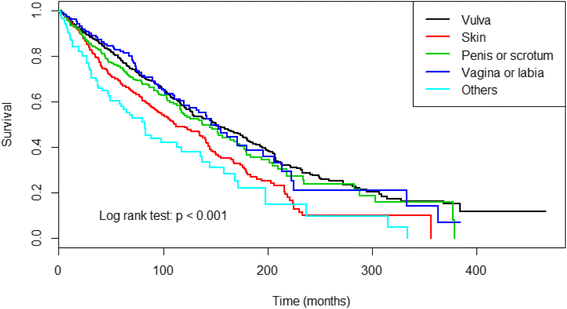Survival analysis of patients with invasive extramammary Paget disease: implications of anatomic sites
- PMID: 29636019
- PMCID: PMC5894213
- DOI: 10.1186/s12885-018-4257-1
Survival analysis of patients with invasive extramammary Paget disease: implications of anatomic sites
Abstract
Background: Extramammary Paget disease (EMPD) is a rare malignant dermatosis with poorly defined outcomes. We investigated clinical characteristics of invasive EMPD at different anatomic sites and by subject demographics to determine prognostic factors for overall survival (OS).
Methods: All patient data were collected from the Surveillance, Epidemiology, and End Results (SEER) program, 1973-2013, of the U.S. National Cancer Institute. Patients with invasive EMPD of skin, vulva/labia, vagina, scrotum/penis, or other sites were included. After excluding patients with unknown radiation status, data of 2001 patients were analyzed. Primary endpoint was EMPD mortality by anatomic sites. Independent variables included patients' demographic data, concurrent malignancy (ie, non-EMPD related cancers), tumor size, distant metastasis, and surgery and/or radiation or not.
Results: Multivariate regression analysis showed that mortality was significantly higher in patients with vaginal EMPD than in patients with vulvar/labial EMPD (adjusted hazard ratio [aHR] = 3.26, p < 0.001). Patients with distant metastasis had higher mortality than those without (aHR = 3.36, p < 0.001). Patients who received surgery had significantly lower mortality than those who did not receive surgery (aHR = 0.77, p = 0.030), and those treated with radiation had significantly higher mortality than those who did not receive radiation (aHR = 1.60, p = 0.002). Older age was associated with significantly increased mortality (aHR = 1.09, p < 0.001), and mortality was significantly higher in males than in females (aHR = 1.42, p = 0.008).
Conclusions: In conclusion, among EMPD patients, mortality is higher in patients with vaginal EMPD than in those with vulvar/labial EMPD and higher in those who are older, those with concurrent malignancy or distant metastasis. Mortality is also higher in males than in females. Surgery is a protective factor and radiation is a risk factor for OS. Greater understanding of EMPD clinical characteristics, and considering EMPD in differential diagnosis of chronic genital and perianal dermatoses may provide support for early EMPD diagnosis and definitive surgical treatment.
Keywords: Anatomic sites; Extramammary Paget disease (EMPD); Surveillance, epidemiology, and end results (SEER); Survival analysis.
Conflict of interest statement
Ethics approval and consent to participate
The institutional review board approval was not required for the SEER program of the National Cancer Institute as it utilizes the de-identified public-use database (
Consent for publication
Not applicable.
Competing interests
The authors declare that they have no competing interests.
Publisher’s Note
Springer Nature remains neutral with regard to jurisdictional claims in published maps and institutional affiliations.
Figures
References
-
- Paget J. On disease of the mammary areola preceding cancer of the mammary gland. St Bartholomew Hosp Rev. 1974;10:87–89.
-
- Crocker H. Paget’s disease affecting the scrotum and penis. Trans Pathol Soc London. 1889;40:187–191.
Publication types
MeSH terms
Grants and funding
LinkOut - more resources
Full Text Sources
Other Literature Sources



